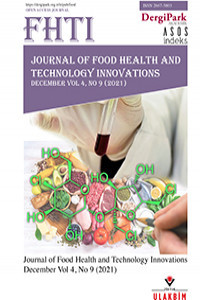Antioxidant activity and organic acid compounds of sour cherry (Prunus cerasus l.,) vinegar in the fermentation process
Antioxidant activity and organic acid compounds of sour cherry (Prunus cerasus l.,) vinegar in the fermentation process
In the present study, sour cherry vinegar was produced from sour cherry juice produced from fresh sour cherries and sour cherry concentrate with rich bioactive component contents, strong antioxidant, antidiabetic, antiobesity, antimutagen, and anticarcinogen properties. In the vinegar production process, changes in total acidity, total soluble dry matter, antioxidant activity, and organic acid composition were examined. The present study mainly aimed to determine the effects of using fresh cherry juice or concentrated cherry juice in vinegar production. Tartaric, malic, and acetic acid organic acids were detected during the production stages of sour cherry vinegar.
In the antioxidant activity analysis by the DPPH method, it was determined that the percentile inhibition level of sour cherry vinegar was higher than those of sour cherry juice and cherry wine. No differences were observed in the component level in the analyses of fresh cherry juice and sour cherry vinegar samples produced from concentrated sour cherry. Therefore, considering that the harvest time of sour cherry is very short, it was concluded that sour cherry vinegar can be efficiently produced from concentrated sour cherry juice regardless of the harvest season.
Keywords:
Cherry vinegar, antioxidant, DPPH, organic acid components acetic acid,
___
- A.O.A.C. Association of Official Analytical Chemists. (2000). Official methods of analysis. Association of official analytical chemist (17th ed.). Washington, D.C., USA.
- Aykin E, Budak HN, Seydim ZB, 2015. Bioactive Components of Mother Vinegar. J Am Coll Nutr 34, 80-89.https://doi.org/10.1080/07315724.2014.896230.
- Budak HN, 2017. Bioactive components of Prunus avium L. black gold (red cherry) and Prunus avium L. stark gold (white cherry) juices, wines and vinegars. J. Food Sci. Technol. 54, 62-70.https://doi.org/10.1007/s13197-016-2434-2.
- Budak HN, Aykin E, Seydim AC, Greene A, Seydim ZB, 2014. Functional Properties of Vinegar. J. Food Sci, 79, 757-764.https://doi.org/10.1111/1750-3841.12434.
- Budak HN, Guzel-Seydim ZB, 2010. Antioxidant activity and phenolic content of wine vinegars produced by two different techniques. J. Sci. Food Agric. 90(12), 2021–2026. https://doi.org/10.1002/jsfa.4047.
- Budak HN, Kumbul Doguc D., Savas CM, Seydim AC, Kök Tas T, Ciris IM, Güzel-Seydim ZB, 2011. Effects of Apple Cider Vinegars Produced with Different Techniques on Blood Lipids in High-Cholesterol-Fed Rats. J. Agric. Food Chem. 59(12), 6638–6644.
- Budak HN., Özdemir N, Gökirmakli Ç, 2021. The changes of physicochemical properties, antioxidants, organic and key volatile compounds associated with the flavor of peach ( L. Batsch) vinegar during the fermentation process. J. Food Biochem, e13978 DOI:10.1111/jfbc.13978.
- Bunea A, Rugina DO, Pintea AM, Sconta Z, Bunea CI, Socaciu C, 2011 Comparative polyphenolic content and antioxidative activities of some wild and cultivated blueberries from Romania. Notulae Botanicae Horti Agrobotanici Cluj-Napoca 39, 70–76.
- Caponio F, Alloggio V, Gomes T, 1999. Phenolic compounds of virgin olive oil: Influence of paste preparation techniques. Food Chem, 64(2), 203–209. https://doi.org/10.1016/s0308 -8146(98)00146-0.
- Casedas G, Les F, Gómez-Serranillos MP, Smith C, López V, 2016. Bioactive and functional properties of sour cherry juice (Prunus cerasus). Food Function, 7(11), 4675-4682.
- Crozier A, Jaganath IB, Clifford MN, 2009. Dietary phenolics: chemistry, bioavailability and effects on health. Dietary phenolics: chemistry, bioavailability and effects on health. Nat. Prod. Rep., 26(8), 10011043.
- Çevik E, 2013. Taze ve Ticari Vişne Sularının Antioksidan Kapasitesi ve Kapiler Elektroforez Yöntemi ile Organik Asit İçeriklerinin İncelenmesi. Master Thesis, Istanbul Technical University, Institute of Science and Technology, Istanbul.
- Kirakosyan A, Seymour EM, Urcuyo DE, Kaufman PB, Bolling SF, 2009. Chemical profile and antioxidant capacities of tart cherry products. Food Chem, 115, 1, 20-25.
- Lara I, Camats JA, Comabella E, Ortiz A, 2016. Eating quality and health-promoting properties of two sweet cherry (Prunus avium L.) cultivars stored in passive modified atmosphere. Food Sci Technol Int 21:133–144.
- Ozturk I, Caliskan O, Tornuk F, Ozcan N, Yalcin H, Baslar M, Sagdic, O, 2015. Antioxidant, antimicrobial, mineral, volatile, physicochemical and microbiological characteristics of traditional home-made Turkish vinegars. LWT-Food Science and Technology, 63(1), 144-151.
- Özdemir GB, Özdemir N, Filiz-Ertekin B, Gökirmakli Ç, Kök-Taş T, Budak HN, 2021. Volatile aroma compounds and bioactive compounds of hawthorn vinegar produced from hawthorn fruit (\n Crataegus\n tanacetifolia\n (lam.) pers.). Journal of Food Biochemistry, 1-14. https://doi.org/10.1111/jfbc.13676.
- Özen M, Özdemir N, Filiz-Ertekin B, Budak HN, Kök TT, 2020. Sour cherry (Prunus cerasus L.) vinegars produced from fresh fruit or juice concentrate: Bioactive compounds, volatile aroma compounds and antioxidant capacities. Food Chem, 30, 125664.
- Plessi M, 2003. Vinegar, Umversita Degli Studi Modena, Elsevier Science Ltd., 5996-6003.
- Ubeda C, Callejo´n RM, Hidalgo C, Torija MJ, Mas A, Troncoso AM, Morales ML, 2011. Determination of major volatile compounds during the production of fruit vinegars by static headspace gas chromatography–mass spectrometry method. Food Res Int 44:259–268.
- ISSN: 2667-5803
- Başlangıç: 2018
- Yayıncı: Dokuz Eylül Teknoloji Geliştirme Anonim Şirketi
